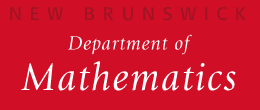Math 552 (Algebra), Spring 2010
Prof. Weibel
Math 552 is the second semester of the standard introductory graduate algebra course. A significant portion of the course is devoted to the theory of field extensions, including Galois theory, rings of polynomials, Nullstellensatz, intro to homological algebra, structure of Artin rings. Additional topics are chosen in part based on the interests of the students.
- Text:
Basic Algebra, by N.Jacobson.
Notices and assignments will appear on this page. - Lectures: MW4 (1:40 to 3:00PM) in Hill 423.
Instructor: Charles Weibel
Homework Assignments (assigned weekly)
| Assigned | Problems | |
|---|---|---|
| 4/26 (due 5/3) |
1. Let R be an infinite product of fields. Show that Spec(R)
is Hausdorff & totally disconnected. 2. If R⊂R' is an integral extension, Spec(R')→Spec(R) is a closed map. 3. Every noetherian valuation domain is a DVR. 4. BA II, 7.9 #3: RG is finitely generated over F, when R is. (Here G is a finite group.) | |
| 4/19 (due 4/26) |
1. BA II, 7.1 #4 (units in polynomial rings) 2. If h:R'→R and P is a prime ideal of R, show that h-1(P) is a prime ideal of R'. 3. Each prime ideal P of R is the kernel of a homomorphism R→F to a field F 4. If S is multiplicatively closed in R, there is a 1-1 correspondence between {ideals of S-1R} and {ideals I of R missing S with (sx∈I⇒x∈I) for all s∈x}. | |
| 4/12 (due 4/19) |
1. Show that the tensor algebra satisfies
HomF-mod(V,A)≅ HomF-alg(TV,A) 2. Let R be an infinite product of fields. Show that J(R)=0. Is R completely reducible as an R-module? 3. If E/F is a separable field extension, and D a division F-algebra, then E⊗FD is semisimple. | |
| 4/7 (due 4/12) |
1. BA II, 4.3 #4 (extending inclusions to endomorphisms) 2. If G is a finite p-group and R=Fp[G], show that (a) the elements g-1 are nilpotent, and they generate a nilpotent ideal of R; (b) there is only one simple R-module up to isomorphism. 3. For both groups of order 6 (D3 and C6), give an isomorphism between the group ring Q[G] and a finite product of matrix rings over fields. | |
| 3/31 (due 4/5) |
1. BA II, 3.5 #4 (completely reducible F[λ]-modules). 2. BA II, 3.5 #7 (completely reducible modules of finite length). 3. For the following rings, (i) describe the simple R-modules and (ii) prove that every R-module is completely irreducible: (a) a division ring D; (b) a matrix ring Mn(F) over a field F; (c) a finite product F1×...×Fn of fields; | |
| 3/24 (due 3/29) |
1. Show that the functor F(M)=M/IM is right exact on R-mod,
for any left ideal I of R
2. Let k be a field. Show that: (a) every left ideal I of Mn(k) has dimk=r n for some r; (b) the left ideals of dimension n are in 1-1 correspondence with points of Pn-1(k) 3. BA II, 3.1 #4 (short 5 lemma) 4. BA II, 3.2 #3 (artinian F{λ]-module) |
|
| 3/10 (Wed) | Midterm on Galois Theory | |
| 3/1 (due 3/8) |
1. Find the Galois group of the real field R over Q. 2. Jacobson 4.14 #1,4 (normal base for Q(√2,√3)) 3. Let E be the field Q(all √p, p prime). Find Gal(E/Q). Hint: Consider the subfields Q(√S) for various sets S of primes. | |
| 2/24 (due 3/1) |
1. Jacobson 4.9 #7 (Casus irreducibilis) 2. Jacobson 4.11 #2 (discriminant of cyclotomic polynomial) 3. Jacobson 4.11 #3 (quadratic subfield of Q(ζ), p=1 or 3 mod 4) 4. Jacobson 4.6 #10: find the Galois group of x4+3x3- 3x -2, using the fact that Gal(f/p) is a subgroup of Gal(f). | |
| 2/17 (due 2/22) |
1. Show that x3- 3x+1 is either irreducible or has 3 roots
over any field; 2. Jacobson 4.8 #7 (the five possible Galois groups of a quartic); 3. Jacobson 4.6 #10 (Galois group of an explicit quartic); | |
| 2/8 (due 2/15) |
1. Jacobson 4.6 #6 (nilpotent groups are solvable); 2. Jacobson 4.6 #10 (the two definitions of nilpotent agree); 3. Jacobson 4.6 #11 using #9 (nilpotent=product of p-groups) | |
| 2/1 (due 2/8) |
1. Show that the Frobenius Φ has order n as an automorphism of
Fq when q=pn. Conclude that Gal(Fq/Fp) is cyclic on Φ 2. Let E be the splitting field of xp-2 over Q. Show that Gal(E/Q) is the semidirect product (Z/p)⋊(Z/p)x 3. Jacobson 4.5 #7. (find EG if E=Fp(t) and t→t+1) | |
| 1/25 (due 2/1) |
1. If F⊆E is a finite field extension,
any F-subalgebra of E is a field. 2. Find a splitting field of x7-1 over F2 |
|
Last modified 04/28/10
Charles Weibel / Spring 2010







